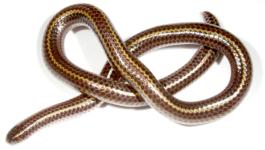
The mantle is a significant part of the anatomy of molluscs: it is the dorsal body wall which covers the visceral mass and usually protrudes in the form of flaps well beyond the visceral mass itself.

Melanophidium bilineatum, commonly known as the two-lined black shield-tail snake or iridescent shield-tail snake, is a species of snake endemic to India. This species was known from only three specimens and very little information is available of it in the wild.
The two-lined blind snake is a harmless blind snake species endemic to Martinique in the Lesser Antilles.

Meghimatium fruhstorferi is a species of medium to large air-breathing land slug, a terrestrial pulmonate gastropod mollusc in the family Philomycidae and the superfamily Arionacea, the roundback slugs.
Gilbertiodendron bilineatum is a species of plant in the family Fabaceae. It is found in Ivory Coast, Ghana, Liberia, and Sierra Leone. It is threatened by habitat loss.

Tetracheilostoma is a genus of snakes in the family Leptotyphlopidae. All of the species were previously placed in the genus Leptotyphlops.

Philomycidae are a family of air-breathing land slugs. They are terrestrial pulmonate gastropod mollusks in the superfamily Arionoidea.
John Bayard Burch was an American zoologist, a biology professor at the University of Michigan, and the Curator of Mollusks at the University of Michigan Museum of Zoology. His research interests are broad, and have encompassed not only the anatomy, systematics, and genetics of mollusks, but also various aspects of zoogeography and parasitology. He has engaged in extensive fieldwork around the world, usually collecting mollusks, especially freshwater and terrestrial species. Some samples taken in Tahiti in 1970 have proven to be of importance in efforts to conserve vanishing kinds of the land snail Partula.

Meghimatium is a genus of medium to large air-breathing land slugs, terrestrial pulmonate gastropod mollusks in the family Philomycidae and the superfamily Arionoidea, the roundback slugs.
Meghimatium burchi is a species of small air-breathing land slug, a terrestrial pulmonate gastropod mollusk in the family Philomycidae and the superfamily Arionacea, the roundback slugs. The specific name burchi is in honor of the American malacologist John B. Burch.
Anthidium clypeodentatum is a species of bee in the family Megachilidae, the leaf-cutter, carder, or mason bees.
Platyarthron is a genus of beetles in the subfamily Cerambycinae, and monotypic tribe Coelarthrini.
Paralcidion bilineatum is a species of beetle in the family Cerambycidae, the only species in the genus Paralcidion.

Neodorcadion is a genus of longhorn beetles of the subfamily Lamiinae, containing the following species:

Neodorcadion bilineatum is a species of beetle in the family Cerambycidae. It was described by Ernst Friedrich Germar in 1824. It is known from Romania, Bosnia and Herzegovina, Hungary, Croatia, North Macedonia, Slovakia, Bulgaria, Greece, Moldova, Montenegro, Albania, Turkey, Serbia, and Ukraine. It measures between 12 and 14 mm.
Catharosoma is a genus of millipedes belonging to the family Paradoxosomatidae.







